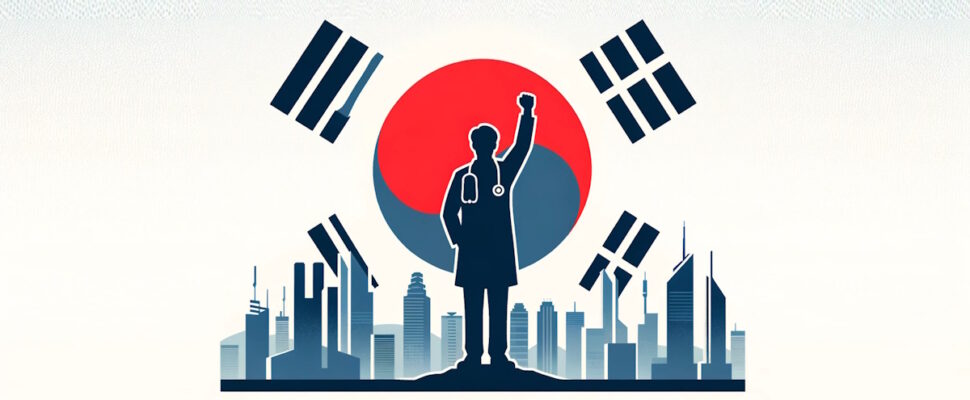Despite its ageing population and growing need for healthcare, South Korea had just 2.6 doctors per 1,000 inhabitants in 2022, one of the lowest numbers among developed nations. To deal with the shortage, the government has created a plan to boost the yearly number of medical students, but this has caused widespread doctor walkouts and protests amid fears
The expansion of medical school quotas is the starting point and an essential task of healthcare reform
Han Duck-soo, Prime Minister
Chronic Shortage of Doctors
South Korea’s doctor-to-population ratio is significantly lower than the 3.7 average for nations in the Organization for Economic Co-operation and Development, despite the country’s aging population and increasing need for healthcare. The lack of doctors is particularly acute in rural areas and in certain key fields such as obstetrics and paediatrics.
Hospitals are particularly bearing the brunt of the shortages and between 2018 to 2022, there were some 37,000 cases of hospitals turning ambulances away with one-third of these cases caused by a lack of physicians.
Boosting Medical School Admissions
To improve the numbers, the government wants to increase medical school admissions, which have remained at 3,058 since 2006, raising the number by 2,000 starting from the 2025 academic year, and eventually adding 10,000 more by 2035.
Previous attempts to up the quota have met with resistance from doctors, and The Korea Medical Association (KMA), a trade union for doctors, has consistently countered government plans to do so. The KMA helped to organise strikes in 2020 after the government’s last attempt to increase medical school numbers, arguing that the plan was not tackling broader systematic problems and that the deficit of doctors in rural areas was due to the poor medical infrastructure and work conditions in those areas.
But this time the government is positioning the move as part of a wider healthcare reform. “The expansion of medical school quotas is the starting point and an essential task of healthcare reform, and the public also recognizes the necessity of the plan and supports the government’s efforts,” said Prime Minister Han Duck-soo at a Cabinet meeting.
In addition to upping admissions to medical schools, president Yoon Suk Yeol’s administration has also pledged to revise bonus schemes to better reward physicians and expand the “local talent selection” programme to reserve at least 40 percent of medical school spots in non-metropolitan areas. The government also foresees introducing a “contractual local resident physician” programme to support doctors’ long-term service.
“It is shameful for us to call ourselves an advanced country if we cannot provide proper medical care to people living in rural areas.” Yoon said. “We will secure sufficient medical personnel and establish a fair compensation system to ensure that essential medical staff who provide high-risk care are paid fairly.”
Continued Opposition from Doctors
The plan has once again caused major resistance among doctors’ groups and led to the mass resignation of some 6,500 of the 13,000 doctors and interns at large hospitals, which has caused delays in surgical procedures and treatments, and a walkout of more than 1,600 trainee doctors at some of the country’s major hospitals.
Doctors’ organizations contend that instead of increasing numbers in medical schools, the government should increase their compensation and the Korea Association of Medical Colleges has called for a much lower admissions increase of 11 percent.
For physicians, expanding numbers is equivalent to lowering their fees, yet after a string of deaths last year resulting from the country’s dearth of healthcare professionals, the public is in favour of the reform with 76 percent of South Koreans supporting it according to a recent Gallup Korea poll.
The average Korean physician earns approximately USD 177,000 a year, almost twice as much as the OECD average, reports The Diplomat, with hospitals in remote areas offering doctors as much as USD 700,000 a year to attract them.
Wider Reform
“Now is the golden time to push forward with healthcare reform,” said President Yoon Suk-yeol at the beginning of this month, referring not only to the medical school plan, but to the government’s projected investment of over UD 7.5 billion in health insurance financing by 2028.
Apart from these reforms, Yoon’s government is proposing to make several concessions to healthcare professionals, including a pilot project to reduce the continuous working hours of medical specialists to 36 hours and a scheme to raise the amount of support for training costs for paediatrics, gynaecology and surgery.
In addition, a law governing medical accidents to ease the burden of criminal penalties for doctors in the event of medical accidents is in the works as well as a project to support insurance premiums for essential medical specialists.
The government’s efforts to solve the issues plaguing the healthcare system come after another significant reform the Yoon administration has been trying to push through, that of the state-run pension fund, the National Pension System (NPS), which is becoming depleted due to the country’s ageing population.
With parliamentary elections scheduled for April 10 2024, the Yoon administration will perhaps have to establish a balance between preserving fiscal prudence in the current economic slowdown and moving forward with its reforms.



